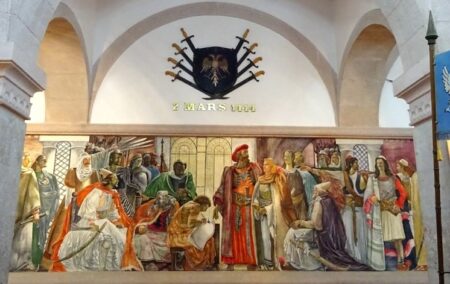This Week in History recalls memorable and decisive events and personalities of the past.
2nd March 1444 – Skanderbeg assembles a group of Albanian nobles to form the League of Lezhë

Albania is a country that has often found itself between two fires in the turbulent region that is the Balkans. Despite Albania’s being bounded to the north and east by Slavic-speaking countries, Albanians are not Slavs, and despite sharing a border with Greece, their language is only a distant cousin of Greek, being classified as its own branch of the greater Indo-European language tree.
As for religion, the story is similar. Albanians today are majority Muslim, although the percentage of the population which is Muslim is hotly disputed, with significant proportions of Greek Orthodox Christians and Catholics making up the rest of the religious population. In the course of their history Albanians have been majority Greek Orthodox, Catholic, and Muslim at various points, a religious heritage personified by the first great Albanian national hero, Skanderbeg.

In the 15th century the Ottoman Empire was rapidly expanding its control across the Balkans. With the collapse of the Serbian Empire (1346–1371) and the fading away of the Eastern Roman Empire, there were few powers in the region to prevent the Ottoman conquest, and by the 1440s the Ottomans had control of most of Greece, Bulgaria, parts of Serbia and Kosovo.
The area of modern-day Albania was deeply politically divided into various principalities and petty fiefdoms, with the lords of the Albanian mountains often switching allegiance between the Venetian Republic, the Serbian kingdom, the Kingdom of Naples and the Ottomans.
Into this chaotic world was born in 1403 a noble by the name of Gjergj Kastrioti – more famously known today by a bastardised version of the name the Ottomans gave him, Skanderbeg.

Skanderbeg’s family background is not well understood. He may have been from a Bulgarian or Serbian Slavic noble’s family, or possibly he was a native Albanian.
Skanderbeg’s father was lord of a small principality in northern Albania and in the early 15th century he swore allegiance to the Ottoman Empire, providing troops, taxes and his own children as hostages to the Ottomans.
This was fairly commonplace and a way the Ottomans expanded their control of new regions; children of new vassals would be taken as hostages to the Ottoman court and killed if their father disobeyed. However, so long as their father remained loyal the children would be educated in Islamic culture, trained in warfare and introduced to the customs and manners of the Ottoman Imperial court.

During this time, despite being born Greek Orthodox, Skanderbeg converted to Islam, and between 1423 and 1443, rose through the ranks of the Ottoman Empire, being granted pieces of land and promoted for his military service.
He likely served alongside the Ottoman army in fighting against the various crusader armies sent from Eastern Europe to drive the Ottomans from the Balkans.

During the Battle of Nis in 1443, Skanderbeg and a small group of around 300 Albanian troops in Ottoman service deserted the Ottoman army as it battled with a crusader force over the Serbian fortress of Nis. Skanderbeg travelled to his homeland and, using a forged letter, got himself appointed as leader of an Ottoman-aligned town in Albania.

Skanderbeg then declared himself heir of an old powerful noble family in the region, converted back to Christianity (this time as a Catholic) and launched a campaign to throw off Ottoman control of northern Albania.
On 2 March 1444, Skanderbeg summoned Albanian noblemen in the Venetian-controlled town of Lezhë and formed the League of Lezhë, an alliance of Albanian nobles who would seek to throw out the Ottomans, with Italian help.
A few months later, Skanderbeg led a force of 15 000 Albanians against an invading army of 40 000 Ottoman troops at the Battle of Torvioll, and to the surprise of everyone smashed the Ottomans, killing half of their army.

For the rest of his life Skanderbeg would be at war, mostly against the Ottomans, but briefly against the city of Venice as well, as he and his allies fought tooth and nail to resist Ottoman invasions, winning stunning victory after victory against them. He even sent troops to fight in a civil war in the Italian kingdom of Naples in 1460.
While Skanderbeg was alive, Albanian resistance continued and the Ottomans were not able to retake the region despite numerous invasions.
However, during a meeting of the League in 1468, Skanderbeg caught malaria and died at the age of 62.
Following his death, the League began to fall apart, finally collapsing in in the 1470s. Many Albanians regard the League as the first Albanian state. Ultimately, however, the Ottomans would be victorious, and Albania would not become independent again until 1913.
If you like what you have just read, support the Daily Friend

